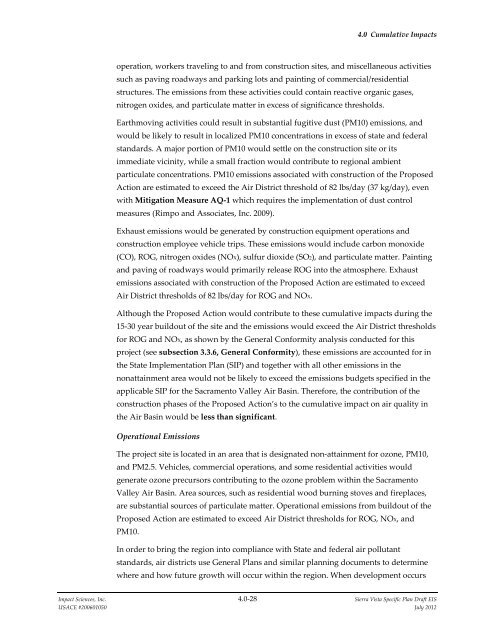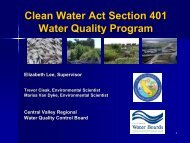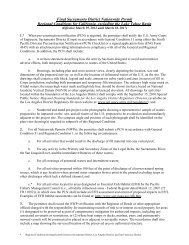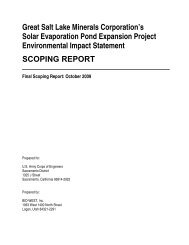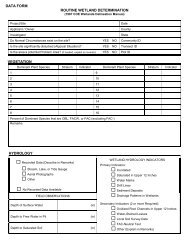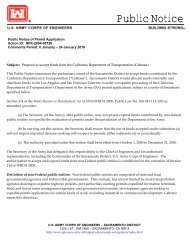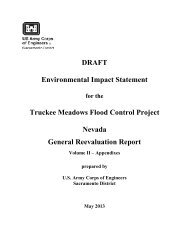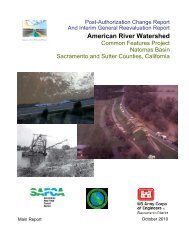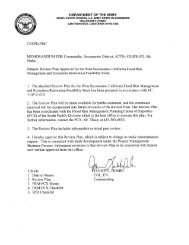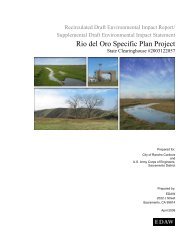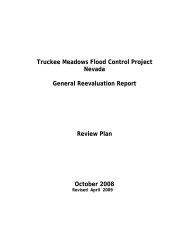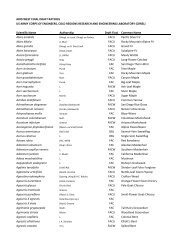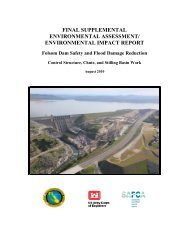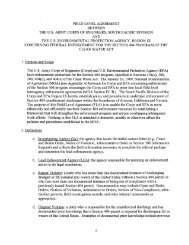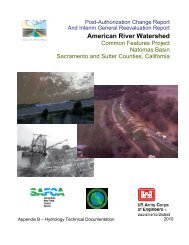4.0 CUMULATIVE IMPACTS - Sacramento District - U.S. Army
4.0 CUMULATIVE IMPACTS - Sacramento District - U.S. Army
4.0 CUMULATIVE IMPACTS - Sacramento District - U.S. Army
You also want an ePaper? Increase the reach of your titles
YUMPU automatically turns print PDFs into web optimized ePapers that Google loves.
<strong>4.0</strong> Cumulative Impacts<br />
operation, workers traveling to and from construction sites, and miscellaneous activities<br />
such as paving roadways and parking lots and painting of commercial/residential<br />
structures. The emissions from these activities could contain reactive organic gases,<br />
nitrogen oxides, and particulate matter in excess of significance thresholds.<br />
Earthmoving activities could result in substantial fugitive dust (PM10) emissions, and<br />
would be likely to result in localized PM10 concentrations in excess of state and federal<br />
standards. A major portion of PM10 would settle on the construction site or its<br />
immediate vicinity, while a small fraction would contribute to regional ambient<br />
particulate concentrations. PM10 emissions associated with construction of the Proposed<br />
Action are estimated to exceed the Air <strong>District</strong> threshold of 82 lbs/day (37 kg/day), even<br />
with Mitigation Measure AQ-1 which requires the implementation of dust control<br />
measures (Rimpo and Associates, Inc. 2009).<br />
Exhaust emissions would be generated by construction equipment operations and<br />
construction employee vehicle trips. These emissions would include carbon monoxide<br />
(CO), ROG, nitrogen oxides (NOX), sulfur dioxide (SO2), and particulate matter. Painting<br />
and paving of roadways would primarily release ROG into the atmosphere. Exhaust<br />
emissions associated with construction of the Proposed Action are estimated to exceed<br />
Air <strong>District</strong> thresholds of 82 lbs/day for ROG and NOX.<br />
Although the Proposed Action would contribute to these cumulative impacts during the<br />
15-30 year buildout of the site and the emissions would exceed the Air <strong>District</strong> thresholds<br />
for ROG and NOX, as shown by the General Conformity analysis conducted for this<br />
project (see subsection 3.3.6, General Conformity), these emissions are accounted for in<br />
the State Implementation Plan (SIP) and together with all other emissions in the<br />
nonattainment area would not be likely to exceed the emissions budgets specified in the<br />
applicable SIP for the <strong>Sacramento</strong> Valley Air Basin. Therefore, the contribution of the<br />
construction phases of the Proposed Action’s to the cumulative impact on air quality in<br />
the Air Basin would be less than significant.<br />
Operational Emissions<br />
The project site is located in an area that is designated non-attainment for ozone, PM10,<br />
and PM2.5. Vehicles, commercial operations, and some residential activities would<br />
generate ozone precursors contributing to the ozone problem within the <strong>Sacramento</strong><br />
Valley Air Basin. Area sources, such as residential wood burning stoves and fireplaces,<br />
are substantial sources of particulate matter. Operational emissions from buildout of the<br />
Proposed Action are estimated to exceed Air <strong>District</strong> thresholds for ROG, NOX, and<br />
PM10.<br />
In order to bring the region into compliance with State and federal air pollutant<br />
standards, air districts use General Plans and similar planning documents to determine<br />
where and how future growth will occur within the region. When development occurs<br />
Impact Sciences, Inc. <strong>4.0</strong>-28 Sierra Vista Specific Plan Draft EIS<br />
USACE #200601050 July 2012


